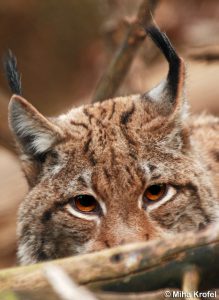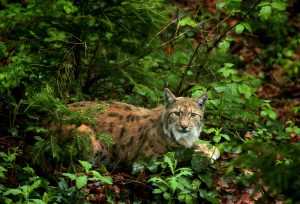
Foto: Miha Krofel
Systematics
The Lynx (genus Lynx) is classified into the order of carnivores (Carnivora) in the cat family (Felidae). Today lynx are distributed over most of the Holarctic and include four species: the Eurasian lynx (Lynx lynx), the Iberian lynx (Lynx pardinus), the Canada lynx (Lynx canadensis) and the bobcat (Lynx rufus). Two of these species are present in Europe – the Eurasian lynx and the Iberian lynx. The Eurasian species is the only one living in Slovenia, Croatia, Italy, Slovakia and Romania. The classification of the Eurasian lynx into its subspecies is still being discussed. The lynx reintroduced to Slovenia originate from the Carpathians and are considered by various authors as belonging to the Lynx lynx lynx or to the Lynx lynx carpathicus subspecies.
Kos I., Potočnik H., Skrbinšek T., Skrbinšek M.A., Jonozovič M., Krofel M. 2004. Ris v Sloveniji. 1. izd. Ljubljana, Biotehniška fakulteta, Oddelek za biologijo: 239 str. (Lynx in Slovenia. Ljubljana, Biotechnical Faculty, Department of Biology. 239 pg.)
Phylogeny and Distribution
The first known representatives of the cat family appeared in the Oligocene epoch. Like all carnivores, they originated from the now extinct family of miacids (Miacoidea). The oldest lynx remains, approximately four million years old, were found in Africa. The ancestor of all current-day lynx is the species Lynx issiodorensis, which was distributed over most of the northern hemisphere. It evolved into the bobcat (Lynx rufus) in North America, the Iberian lynx (Lynx pardinus) in Europe and the Eurasian lynx (Lynx lynx) in Asia. Later, the Eurasian lynx colonized Europe, where it replaced the Iberian lynx over most of the area, with the exception of the Iberian Peninsula.
Today’s distribution of the lynx in Europe is, apart from the effects caused by man, largely a result of the events that took place in the late Pleistocene. Two key events at that time were the arrival of the Eurasian lynx into Europe and a significant decrease in the geographical ranges of both Eurasian and Iberian lynx at the height of the Würm glacial. How the Eurasian lynx came to replace the Iberian lynx over the larger part of Europe is not yet completely understood. Some findings show that, for some time at least, the two species appeared sympatrically. In the late Pleistocene, the Eurasian lynx also expanded its range into North America, where it evolved into the Canada lynx (Lynx canadensis).

Foto: Miha Krofel
The climate was getting harsher towards the end of the Würm glacial, with the ice age reaching its peak approximately twenty thousand years ago. At that time, most of Europe was covered in ice, tundra and steppe. Lynx populations persevered in the forested refuges in the south. After the peak of the Würm glacial, the climate became warmer and forests started to expand, and with them the geographical range of the lynx.
The most important role in lynx evolution is availability of prey and influence of competitors. Most lynx species, with exception of the Eurasian lynx, have adapted to preying on hares and rabbits (Leporidae), which resulted in a gradual decrease in body size. This enabled them to survive in an environment with low density of small ungulates, allowing them to avoid competition with larger predators.
Kos I., Potočnik H., Skrbinšek T., Skrbinšek M.A., Jonozovič M., Krofel M. 2004. Ris v Sloveniji. 1. izd. Ljubljana, Biotehniška fakulteta, Oddelek za biologijo: 239 str. (Lynx in Slovenia. Ljubljana, Biotechnical Faculty, Department of Biology. 239 pg.)
